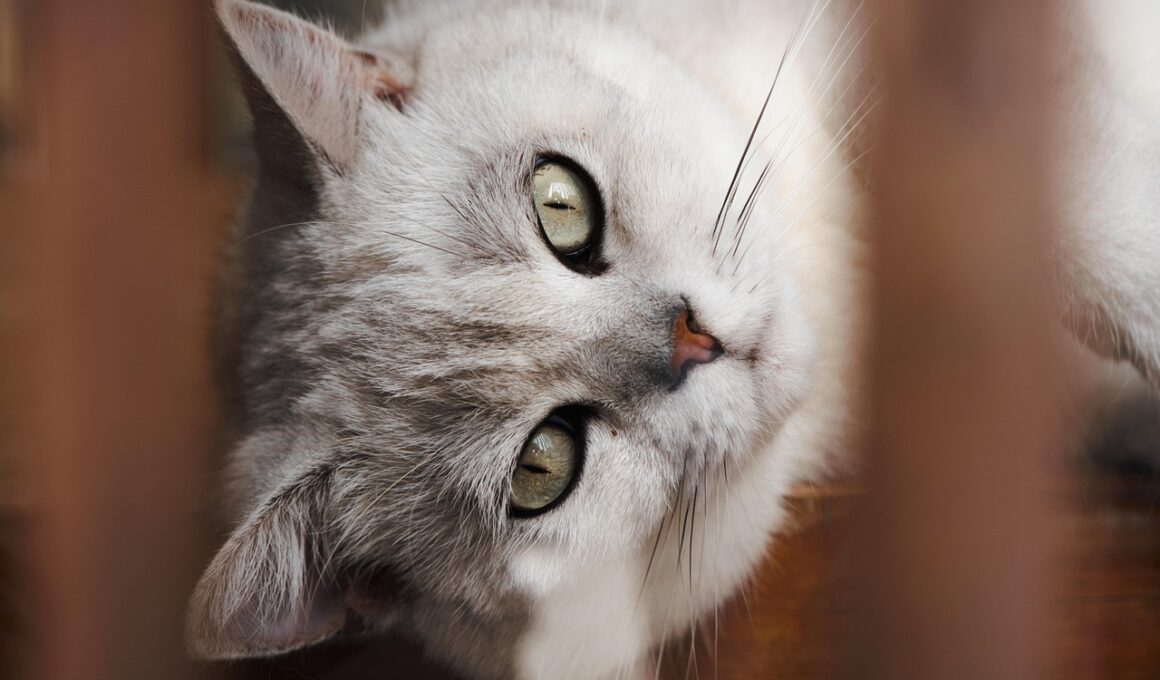Lifecycle of Giardia in Cats and How to Prevent Infection
Giardia is a microscopic parasite affecting various animals, including cats. Understanding its lifecycle is crucial for effective prevention and control. The lifecycle starts when cysts are ingested through contaminated food or water. These cysts reach the intestines, where they develop into trophozoites, the active form of the parasite. Here, Giardia can effectively disrupt the digestive process, leading to symptoms like diarrhea and weight loss. Cats often become infected during episodes of stress or changes in their environment, such as moving to a new home. Understanding how these cysts spread is pivotal for cat owners. Proper sanitation, such as regularly cleaning litter boxes and ensuring a clean water supply, can drastically reduce the risk. Pet owners should also avoid areas where infected animals roam. Keeping your cat’s environment clean serves as a primary defense against Giardia. If you suspect your cat may have contracted Giardia, it is essential to consult a veterinarian for a precise diagnosis and treatment program tailored to your cat’s needs. Knowledge of Giardia’s lifecycle and prevention strategies can help keep your feline friend safe and healthy.
Once ingested, cysts of Giardia are highly resistant and can survive outside a host in the environment, posing a health risk to your cat. When in a cat’s intestines, trophozoites multiply and attach to the intestinal lining, which can result in inflammation and digestive upset. This can lead to long-term health issues if left untreated. Symptoms of Giardia infection in cats often include foul-smelling diarrhea, vomiting, and weight loss. To confirm an infection, a vet will conduct a fecal test, which reveals the presence of cysts or trophozoites. It is essential for cat owners to be vigilant and monitor their pets closely for any signs of illness. If your cat displays symptoms or if you have multiple pets, it’s crucial to act quickly. Isolation of the affected cat may be necessary to prevent the spread of the parasite. Additionally, maintaining hygiene in your household is vital in managing and preventing Giardia infections. One effective method is thorough cleaning of all surfaces and belongings that your cat may have come in contact with, which diminishes the chances of reinfection or spread.
Symptoms and Diagnosis of Giardia in Cats
Identifying Giardia infections in your cat can be challenging, as symptoms often resemble other gastrointestinal issues. The most common signs include persistent diarrhea, lethargy, and decreased appetite. Some cats may also present with noticeable weight loss, indicating a lack of nutrient absorption. If you notice any of these symptoms, prompt veterinary consultation is required. Your veterinarian will likely recommend a fecal examination to confirm the presence of Giardia cysts or trophozoites. It’s important to provide your vet with a complete history of your cat’s behavior and any potential exposure to other animals. Besides fecal testing, other diagnostic methods, including blood tests, may help rule out additional health problems. Treatment for Giardia typically involves specific antiparasitic medications, which your veterinarian will recommend based on the severity of the infection. It’s crucial to follow all treatment guidelines carefully to ensure your cat’s recovery. While treatment can be effective, reinfection is possible if environmental factors are not addressed, emphasizing the importance of sanitation and regular vet check-ups.
Preventing Giardia in cats involves a combination of good hygiene practices and monitoring your cat’s environment closely. Regular cleaning of litter boxes is crucial, as Giardia cysts can easily survive in soil and feces. Designate a specific area for your cat’s toilet and keep it sanitary at all times. Make it a routine to wash your hands after handling litter or cleaning surfaces. Additionally, provide fresh, clean water at all times while ensuring it isn’t sourced from potentially contaminated areas. If you have multiple pets, consider isolating any new or sick animals until you determine their health status. Routine veterinary check-ups are also critical to catching early signs of any infections quickly and effectively. Discuss with your veterinarian about vaccinations, as some vaccines can help strengthen your cat’s immune system. It’s also wise to avoid letting your cat interact with stray animals, particularly in outdoor areas where Giardia may be present. By adopting these steps, you greatly reduce the risk of infection and promote better health for your feline companions.
Environmental Management to Control Giardia
Controlling Giardia involves not just treatment but also effectively managing the environment your cats live in. Since Giardia cysts can remain viable in soil for long periods, focus on cleaning outdoor spaces where your cat roams. Regularly disinfect surfaces where your cat eats, sleeps, or plays to limit contamination. For outdoor areas, keep your yard as clean as possible and free from animal waste that can harbor the parasite. If your cat defecates outside, scoop immediately and dispose of waste appropriately. Also, consider the importance of limiting your cat’s exposure to stagnant water sources, such as ponds or puddles, where parasites can thrive. Using appropriate disinfectants when cleaning can help eliminate existing cysts in your home. Additionally, educate yourself and family members about parasite control measures. Engage in conversations about responsible pet ownership and the role everyone plays in keeping pets healthy. By working as a unit, you can create an environment less conducive to the survival and transmission of parasites like Giardia.
Regular vet check-ups and monitoring are vital components of preventing Giardia infections in cats. Consistently monitoring your cat’s health can help catch any issues early, enabling timely intervention. Pay close attention to their diet and overall behavior, as changes might indicate digestive issues. It’s essential to maintain open lines of communication with your veterinarian, discussing any concerns regarding Giardia or other parasites. When traveling, ensure that your cat is not exposed to potentially risky environments, particularly where other animals might congregate. If you are introducing new pets into your home, make it a habit to quarantine them until you are sure they are healthy. In cases where Giardia has been diagnosed, cleaning your entire home’s environment becomes paramount to reduce reinfection risk. Remember, the presence of one infected animal can pose a risk to the health of others due to environmental contamination. Ensuring a consistent and proactive approach can help maintain the health and well-being of your feline friends and can significantly lessen the chances of Giardia outbreaks.
Conclusion: Protecting Your Cat From Giardia
In conclusion, understanding the lifecycle of Giardia in cats is essential for effective prevention and disease management. By implementing good hygiene and regular veterinary care, cat owners can significantly mitigate the risks associated with Giardia infections. Recognizing symptoms early allows for timely treatment and improves the odds of successful recovery. It is equally important to maintain a clean living environment, minimizing the potential for parasite transmission. Always educate family members and any pet caretakers about best practices for hygiene and sanitation in relation to cat care. Knowledge is power when it comes to protecting your pets. It’s also critical to be vigilant about any introductions of new animals into your household. Working together with your veterinarian can create a preventive strategy tailored to your cats’ healthcare needs. Taking these steps ensures that your cats lead healthy and happy lives, free from the burdens of Giardia and other parasites. Ultimately, the goal is to foster an environment that supports your pet’s health and safety while enriching your time together.
Remember that prevention is always easier than treatment. Understanding the lifecycle of parasites such as Giardia is essential for safeguarding your pet’s health. Always prioritize vigilance, cleanliness, and proper veterinary care in your cat’s routine. By maintaining a proactive stance against these parasites, you not only protect your pets but also contribute to the well-being of your household. By ensuring your feline friend receives the best possible care, you can help them thrive and enjoy a long, healthy life without the worries that parasites bring.


